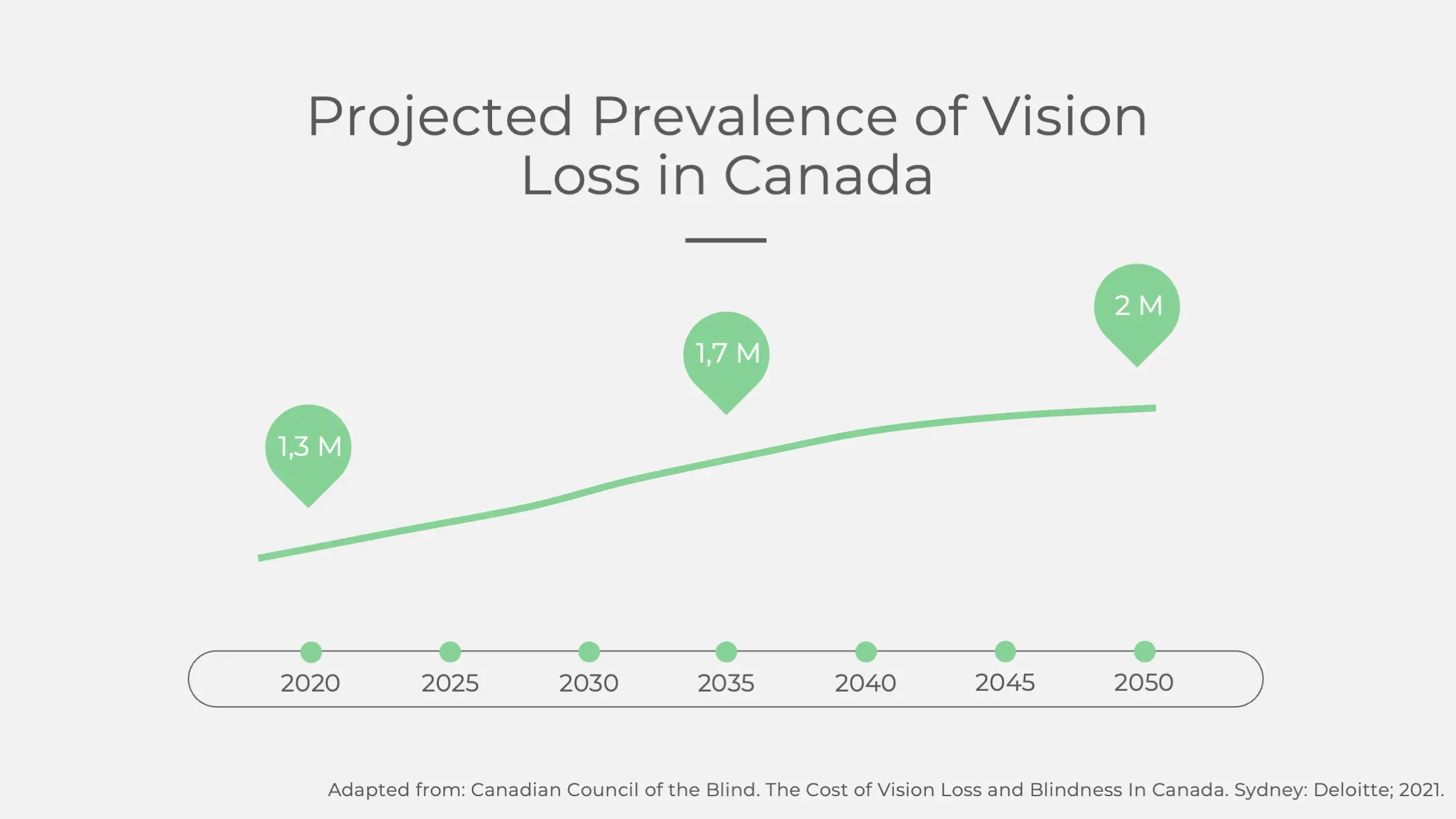Consequences of Vision Loss and the Importance of Early Diagnosis

Prevalence of Vision Loss
There are approximately 1.2 million people living with vision loss and blindness in Canada as of 2019. For the purposes of the CCB report, vision loss was defined by a best-corrected visual acuity measurement of 20/40 in the better-seeing eye. Blindness was described by a visual acuity of 20/200 or worse in the better-seeing eye. (1)
Data suggest that vision loss and blindness have increased exponentially over time. Alarmingly, while the Canadian population has increased by 14.3% in the last 12 years, vision loss and blindness have increased by 46.8%. (1)

Causes of Vision Loss
When it comes to the underlying cause for vision loss, the top etiology is cataract, at 37%. The next most prevalent causes of vision loss include macular degeneration (15%), glaucoma (11%) and diabetic retinopathy (9%). (1)
With the projected population growth, especially within seniors, it is estimated that vision loss will affect 2.0 million people by 2050. (1)
Globally, more than 2.2 billion people have vision impairment. In almost half of these cases, vision impairment is preventable or has yet to be addressed. The leading etiologies, from most to least prevalent, are uncorrected refractive error, cataract, glaucoma, corneal opacities, diabetic retinopathy, and trachoma. (2)
Other Causes
There are causes of vision loss that vary widely between individuals. Each one is not that common in and of itself, but together they account for the highest proportion of vision loss cases in Canada.
Cataract
Cataracts are not entirely preventable but thankfully can be removed and leading to restored vision.
Age-related Macular Degeneration
Age-related macular degeneration, whether wet or dry, results in a progressive decline in central acuity, sparing peripheral vision. It detrimentally affects one’s independence and quality of life, due to its effects on the ability to drive, watch television, and recognize faces. There are an estimated 2.5 million Canadians living with age-related macular degeneration. (1)
Glaucoma
There are approximately 728,000 Canadians living with glaucoma (1), but this number could be an underestimate. This is because more than 50% of glaucoma patients do not realize they have it. (4)
Diabetic Retinopathy
There are 1.0 million people with diabetic retinopathy in Canada. (1) Blood sugar control is paramount in preventing or slowing the course of this disease. It is also imperative that diabetic retinopathy is diagnosed early for prompt treatment and best prognosis.
Cost of Vision Loss
In 2019, the total cost of vision loss in Canada was estimated at $32.9 billion, including $15.6 billion in financial cost, and $17.4 billion in lost well-being. (1)
Health Care Costs
Canadian health care system costs for vision loss added up to $9.5 billion in 2019. This included vision care (optometrists, opticians and eyewear), pharmaceuticals, outpatient care, hospital care, and other relevant expenses. Patients bore the majority of the cost burden, at 65%, while the government assumed 35%. (1)
Productivity Costs
Vision loss impacts productivity in many ways. Individuals have fewer job opportunities, more absences from work, and reduced productivity at work when they do not have adequate support. Earnings are often lost as a result of an early departure from the workforce due to premature mortality. In addition, family, friends, and caregivers become less productive in their own lives while providing care for their loved one. In 2019, this resulted in $4.3 billion of lost productivity in Canada. (1)
Well-being Costs
Ultimately, vision loss takes a toll on one’s physical and mental well-being, resulting in an estimated total of $17.4 billion relevant costs in Canada in 2019. Loss of well-being can be measured in disability-adjusted life years (DALY), which tallies the number of years of healthy life lost due to disability. The DALY for vision loss was found to be 41,613, greater than that of many conditions, including eating disorders, skin melanoma, and upper respiratory tract infections. With the growing rates of vision loss with age, the impact on well-being increases accordingly. (1)
When a vision condition can be prevented, individual, and society costs can be decreased accordingly.
Importance of Early Diagnosis
Some conditions that affect eyesight have modifiable risk factors, while others do not. When a vision condition can be prevented, individual, and society costs can be decreased accordingly. Preventive approaches are key to minimizing blindness and vision loss. Therefore, promoting public health measures can act as an impactful modifiable risk factor for vision-threatening conditions. The importance of regular comprehensive dilated eye exams by optometrists and ophthalmologists cannot be emphasized enough.
Technology can be utilized to aid in diagnosing these conditions earlier, as this is crucial to prevent vision loss in many eye disease processes. Recent advancements have allowed us to better understand the pathophysiology of glaucoma. More specifically, emphasis is being shifted from intraocular pressure to the loss of metabolic function of the optic nerve. These changes could precede the structural damage seen on fundus photography and optical coherence tomography, or the functional changes revealed with visual field testing.
There is increasing evidence that the loss of metabolic function in the optic nerve is linked to oxygen dysregulation (3). Ocular oximetry measurement allows for the observation of metabolic function over time, potentially allowing for earlier diagnosis and better monitoring of treatment.
Zilia Ocular is the first retinal camera offering continuous and targeted ocular oximetry monitoring. This combined imaging and spectrometry device allows for the non-invasive measurement of metabolic function.
Conclusion
The costs of vision loss and blindness are rising. Priority should be given to reducing the devastating impact at an individual and societal level by implementing public health measures, as well as improving methods for the prevention and management of ocular diseases. Zilia Ocular may allow for earlier identification of several vision threatening conditions, including macular degeneration, glaucoma and diabetic retinopathy. Earlier diagnosis would permit intervention at a nascent stage of the disease, before catastrophic consequences ensue.
References
- Canadian Council of the Blind. The Cost of Vision Loss and Blindness In Canada. Sydney: Deloitte; 2021. https://www.fightingblindness.ca/wp-content/uploads/2021/05/Deloitte-Final-Acc-of-VL-and-Blindness-in-Canada-May-2021.pdf. Accessed June 24, 2021.
- Vision impairment and blindness. Who.int. https://www.who.int/news-room/fact-sheets/detail/blindness-and-visual-impairment. Published 2021. Accessed June 24, 2021.
- J. Boeckaert, E. Vandewalle, and I. Stalmans, “Oximetry: recent insights into retinal vasopathies and glaucoma,” Bull Soc Belge Ophtalmol, vol. 319, pp. 75–83, 2012.
- Burr JM, Mowatt G, Hernández R, Siddiqui MA, Cook J, Lourenco T, et al. The clinical effectiveness and cost-effectiveness of screening for open angle glaucoma: a systematic review and economic evaluation. Health Technology Assessment. 2001;
Written by the Zilia Team on July 7, 2021
More on our Blog
Zilia Partners with Kagawa University for Groundbreaking Retinal Oxygenation Study in Japan
Quebec City, Apr. 30, 2024 - Zilia, a pioneer in non-invasive ocular biomarker technologies, announces a...
Oxygen’s Complex Role in Retinopathy of Prematurity
Premature birth is a remarkable feat of medicine. However, this early entrance into the world can sometimes...
Oxidative Stress and Eye Health
Oxygen plays an important role in our universe, being the third most abundant element and the second most...
Solutions


